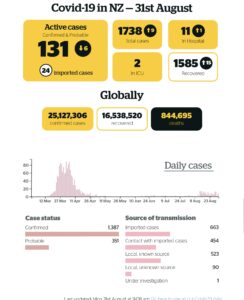There are nine new Covid cases in New Zealand today – four in MIQ and five in the community.
Three of the community cases are linked to the Mt Roskill church and the others are household contacts of previously confirmed cases.
There are 28 close contacts identified of the Tokoroa health professional who is in hospital.
And 128 people related to the community cluster have transferred to MIQ, including 85 who have tested positive.
Eleven people are in hospital – two of whom are in intensive care.
There are 131 active cases – of which 24 are imported cases in MIQ – and 7219 tests were processed yesterday.
Health Minister Chris Hipkins and acting director of public health Robyn Shearer are giving the daily 1pm press briefing.
Shearer said there was “significant pressure” on people at the moment and there was mental health support if needed. She said it was “okay to not be okay”.
The number of tests being carried out “was at a good level” and yesterday’s test numbers brought the total number tested to more than 60,000 since the start of the recent “testing blitz”, Hipkins said.
He said the policy was still to move people who test positive into MIQ, despite numbers starting to fall.
The cases are all still linked either epidemiologicaly or genomically, he said.
As part of the contact tracing systems, close contacts are “typically” tested twice – when they’re first contacted and at around day 12. He said “the vast majority” were getting that second day-12 test.
Hipkins said the incorrect messaging on the Ministry of Health website about South and West Aucklanders requiring testing was information that had been “lost in translation”.
He said he was confident everyone involved in the error had learned from it.
Hipkins first learned about the miscommunication yesterday morning, after a radio interview.
He said health officials were “grappling” with getting people tested who weren’t symptomatic.
He conceded that information “could have been clearer”.
“The buck ultimately stops with the Government and I clearly take responsibility for that, and so does the Prime Minister.”
Hipkins said he wasn’t interested in “pointing the finger” or apportioning blame for the incorrect information being pushed out.
He believed there might have been some confusion around being in an election period and officials not running every ad for sign-off past ministers.
He understood there was a flurry at testing sites yesterday morning after the misinformation went out, but demand fell away after it was corrected.
Shearer said there was a review underway and they were working on improving their communications.
Director general of health Dr Ashley Bloomfield was on leave “spending time with his family”, Shearer said.
Auckland Transport had reported 90 per cent of passengers were wearing masks and police are handing masks out to people who don’t have one, Hipkins said.
Hipkins said the alert level system was designed to accommodate for isolated clusters in the community – and all the new cases were known to each other so people should have confidence in Auckland’s move out of lockdown.
He said he knew it had been a “frustrating and difficult” time and thanked Aucklanders for following the rules and businesses for being patient.
Hipkins said the “relatively minor” inconveniences of handwashing and wearing a mask were worth it if it meant not having to go back into lockdown.
Hipkins said the number of QR scans each day was about 1.6 million. He said people without smartphones should manually record their movements.
From Friday, QR codes will be mandatory on public transport.
There will be another update to the app coming soon which will allow people to store their NHI numbers and manually edit visits.
Hipkins understood parents’ anxiety about sending their children back to school but said it was safe for them to do so. He said it was not okay to keep children at home.
“Their futures depend on this.”
Hipkins said he had “no problem” with the Health Select Committee reforming and he was happy to answer questions.
Epidemiologists and the Government have warned the Auckland cluster will continue to grow – but the key is whether all the cases can be connected.
And it is because the Auckland cluster continues to grow that the Government moved the city into, what Prime Minister Jacinda Ardern described as, level 2.5.
This is not an official alert level, rather a heightened version of the level 2 that Auckland has already experienced.

